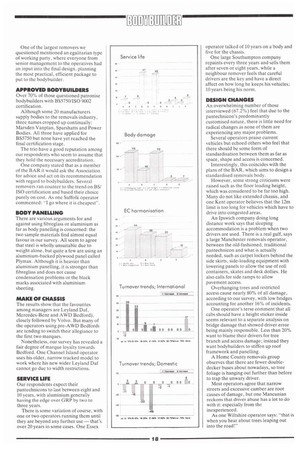YBUI ER
Page 132

If you've noticed an error in this article please click here to report it so we can fix it.
One of the largest removers we questioned mentioned an egalitarian type of working party, where everyone from senior management to the operatives had an input into the final design, planning the most practical, efficient package to put to the bodybuilder.
APPROVED BODYBUILDERS
Over 70% of those questioned patronise bodybuilders with BS5750/1S0 9002 certification.
Although some 20 manufacturers supply bodies to the removals industry, three names cropped up continually: Marsden Vanplan, Sparshatts and Power Bodies. All three have applied for BS5750 but none have yet reached the final certification stage.
The trio have a good reputation among our respondents who seem to assume that they hold the necessary accreditation.
One company stated that as a member of the BAR it would ask the Association for advice and act on its recommendation with regard to bodybuilders. Several removers ran counter to the trend on BS/ ISO certification and based their choice purely on cost. As one Suffolk operator commented: "I go where it is cheapest".
There are various arguments for and against using fibreglass or aluminium as far as body panelling is concerned: the two sample materials find almost equal favour in our survey. All seem to agree that steel is wholly unsuitable due to weight alone, but quite a few are using an aluminium-backed plywood panel called Plymax. Although it is heavier than aluminium panelling, it is stronger than fibreglass and does not cause condensation problems or the black marks associated with aluminium sheeting.
The results show that the favourites among managers are Leyland Daf, Mercedes-Benz and AWD Bedford), closely followed by Volvo. But many of the operators using pre-AWD Bedfords are tending to switch their allegiance to the first two marques.
Nonetheless, our survey has revealed a fair degree of marque loyalty towards Bedford. One Channel Island operator uses his older, narrow tracked model to work where his new wider Leyland Daf cannot go due to width restrictions.
Our respondents expect their
pantechnicons to last between eight and 10 years, with aluminium generally having the edge over GRP by two to three years.
There is some variation of course, with one or two operators running them until they are beyond any further use — that's over 20 years in some cases. One Essex operator talked of 10 years on a body and five for the chassis.
One large Southampton company repaints every three years and sells them after seven or eight years, while a neighbour remover feels that careful drivers are the key and have a direct affect on how long he keeps his vehicles; 10 years being his norm.
An overwhelming number of those interviewed (67.2%) feel that due to the pantechnicon's predominantly customised nature, there is little need for radical changes as none of them are experiencing any major problems.
Several operators praise current vehicles but echoed others who feel that there should be some form of standardisation between them as far as space, shape and access is concerned.
Interestingly, this coincides with the plans of the BAR, which aims to design a standardised removals body.
However, some strong criticisms were raised such as the floor loading height, which was considered to be far too high. Many do not like extended chassis, and one Kent operator believes that the 12m limit is too long for vehicles which have to drive into congested areas.
An Ipswich company doing long distance work says that sleeping accommodation is a problem when two drivers are used. There is a real gulf, says a large Manchester removals operator, between the old-fashioned, traditional pantechnicon and what is actually needed, such as carpet lockers behind the side skirts, side-loading equipment with lowering panels to allow the use of roll containers, skates and desk dollies. He also calls for side ramps to allow pavement access.
Overhanging trees and restricted access cause nearly 80% of all damage, according to our survey, with low bridges accounting for another 16% of incidents.
One operator's terse comment that all cabs should have a height sticker inside seems relevant to a separate analysis on bridge damage that showed driver error being mainly responsible. Less than 20% want to blame their drivers for tree branch and access damage; instead they want bodybuilders to stiffen up roof framework and panelling.
A Home County removals group observes that there are fewer doubledecker buses about nowadays, so tree foliage is hanging out further than before to trap the unwary driver.
Most operators agree that narrow streets and excessive camber are root causes of damage, but one Mancunian reckons that driver abuse has a lot to do with it: especially from the inexperienced.
As one Wiltshire operator says: "that is when you hear about trees leaping out into the road!"






















































































































































